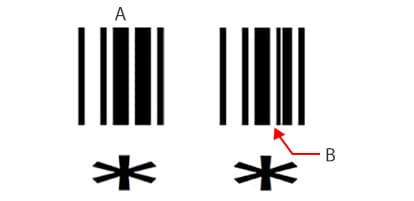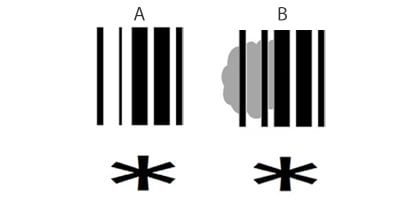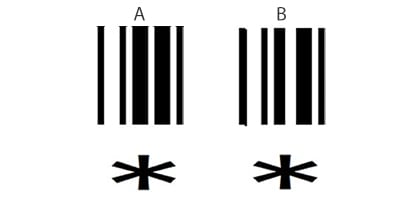ISO/IEC 15416 Verification Items and their Meanings
- 1 DEC(Decode)
- 2 EDGE(Edge Determination)
- 3 SC(Symbol Contrast)
- 4 MINR(Minimum Reflectance)
- 5 MINE(Minimum Edge Contrast)
- 6 MOD(Modulation)
- 7 QZ(Quiet Zone)
- 8 DCD(Decodability)
- 9 DEF(Defects)
1 DEC(Decode)
Judges whether reading is possible when decoding is performed.
If the grade of this item is low, it may not be possible to identify the barcode as such.
2 EDGE(Edge Determination)
Judges whether the read number of barcode edges (points where the color switches between white and black) equals the expected number of edges.
As shown in the bottom-right image, the inclusion of white lines due to factors such as scratches reduces the grade.

- A
- Correct
- B
- Scratch
3 SC(Symbol Contrast)
Evaluates the difference between the maximum light intensity (Rmax) and the minimum light intensity (Rmin) within the code area.
If an overall contrast is not sufficient, the grade is low.

4 MINR(Minimum Reflectance)
This is the minimum reflectance in the scan waveform.
Evaluates whether the minimum light intensity (Rmin) is 50% or less of the maximum light intensity (Rmax).
If the bars are marked in an overall light manner, the grade is low.
5 MINE(Minimum Edge Contrast)
Evaluates whether the minimum difference in reflectance between a space (including the quiet zone) and its neighboring bars is 15% or less.
If some bars are narrow or if part of the background is dirty, the grade is low.
6 MOD(Modulation)
Evaluates the ratio of the minimum edge contrast to the symbol contrast.
If some bars are narrow or if part of the background is dirty, the grade is low.

- A
- Some bars are narrow.
- B
- Dirt is present.
7 QZ(Quiet Zone)
Evaluates whether the quiet zone width meets the standard.

- A
- Quiet zone
8 DCD(Decodability)
The decodability is determined for each code type. This evaluates the size of the error between the ideal line width pattern and the actual line width pattern.
If bars or spaces are too wide or too narrow, the grade is low.

- A
- Correct
- B
- Incorrect bar width
9 DEF(Defects)
Evaluates uneven colors within elements.
If bars or spaces are flawed or dirty, the grade is low.




